A Comprehensive Guide on How to Choose the Perfect Pool Liner
Selecting a pool liner is more than deciding which shade of blue you like best. A liner is the critical waterproofing membrane that protects the structure beneath, shapes the color of the water, and defines how the surface feels underfoot. At Royal Swimming Pools, we’ve spent three decades helping homeowners match the right vinyl to the right pool. Consider us your insider resource as you compare pool liner options, from entry-level above-ground replacements to bespoke inground patterns.
Why the Right Pool Liner Matters
The liner is the pool’s single, continuous defense against leaks, abrasion, and chemical attack. By sealing water inside and forming a smooth, forgiving surface underfoot, it protects structural walls—steel, polymer, or concrete—from rust and etching.
Durability depends as much on precision fit and additive package as on sheer thickness. A 20-mil liner that’s vac-set tight to every contour can outperform a loose 27-mil sheet, yet those extra mils still pay off when the floor is rough or playtime gets rowdy. UV inhibitors, plasticizers, and antimicrobial topcoats further extend service life, so the “best” liner is the one whose material, thickness, and cut align with how the pool is built and how it will be used.
Types of Pool Liners
| Liner Type | Install Type | Best For | Pros | Cons |
| Overlap | Vinyl drapes over wall and is clamped by coping | Above-ground pools |
|
|
| Beaded (standard) | Bead snaps into a receiver track | Above-ground or inground pools with straight wall height |
|
|
| Unibead/J-hook | Liner has built-in hook, can also work as bead | Above-ground owners who may add a track later |
|
|
| Expandable Overlap | Stretchable vinyl for hopper or deep areas | Above-ground pools with 5–6 ft deep ends |
|
|

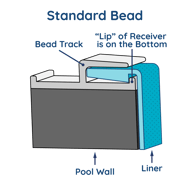

If you’d like a deeper look at how each vinyl liner bead works, you can read more here.
Choosing the Right Pool Liner Thickness
When it comes to pool liners, thickness plays a direct role in both durability and how well the liner conforms to the pool shape. You’ll see two measurements used—mil and gauge—but they aren’t the same.
Mil refers to one-thousandth of an inch and is a consistent, regulated unit. Gauge is a less standardized term used in marketing, and the actual thickness can vary depending on the manufacturer. Whenever possible, ask for the mil rating to make an informed comparison.
There’s a tradeoff between ease of installation and long-term toughness. The right thickness depends on your pool’s structure, usage, and who’s doing the installation. Thinner liners are easier to work with—especially on steps, corners, or more complex pool shapes—since they stretch into place more readily. Thicker liners offer more resistance to punctures and chemicals but are heavier and less forgiving during installation, particularly in cooler temperatures when vinyl becomes less pliable.
| Common spec | Approx. thickness | Typical use-case |
| 20 mil/30 gauge | 0.020 in (~0.51 mm) | Flexible, easier to stretch into corners Preferred by many builders for a wrinkle-free fit |
| 27–28 mil/35 gauge | 0.027 – 0.028 in | Extra puncture and chemical resistance Heavier weight to manage during install |
| 30 mil | 0.030 in (0.76 mm) | Commercial pools or rough concrete bottoms Longest warranty but most rigid |
What Makes a Pool Liner Durable?
A long-lasting liner depends on more than an impressive mil rating. Vinyl formulation, how the sheets are welded, and the protective chemistry baked into the surface all influence whether the material keeps its color, wards off pinholes, and stays flexible season after season. When you request quotes, dig beyond thickness and ask suppliers to spell out exactly what goes into the liner.
- Virgin vinyl: produced from first-run resins for consistent elasticity and fewer hidden weak spots.
- UV inhibitors: blended-in stabilizers that slow chalking and fading caused by relentless sunlight.
- Fungicides & antibacterial inks: pigments treated to resist waterline stains from algae and microbes.
- High-frequency welded seams: precision welding that distributes stress evenly and prevents seam splits.
- Protective topcoat: a transparent shield that guards printed patterns against abrasion, chlorine, and sunscreen oils.
Confirm the resin source, additive package, and seam warranty in writing—those details predict whether a liner will perform for one swim season or many.
Color & Pattern Considerations
Liner colors double as underwater lighting design. Light blues and whites reflect sunlight, giving water a sparkling Caribbean feel. Darker teals or indigos absorb light for a dramatic lagoon effect and can nudge water temperature a few degrees higher in sunny climates.
Standard Color Options
- Light Blue: The highest-reflectivity option, giving the water a bright, crystalline appearance. Light Blue enhances visibility and sparkle, making it ideal for families who prefer a clean, classic look with maximum light return.
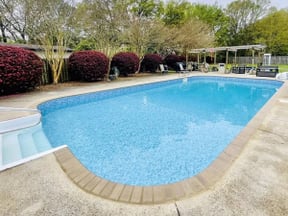
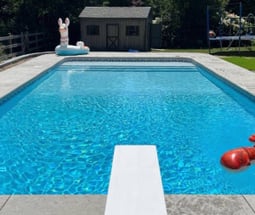
- Medium Blue: A neutral, well-balanced shade that keeps water looking crisp without being overly bright. Medium Blue tends to mimic the tone of natural lakes or traditional swimming pools, offering dependable color in a wide range of outdoor settings.

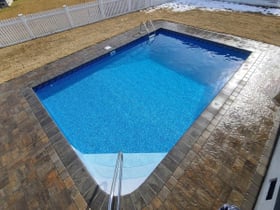
- Dark Blue: A deeper shade that creates dramatic visual depth and a luxurious, lagoon-like appearance. Dark Blue absorbs more UV light, subtly increasing water warmth and adding richness to both patterned and solid liner designs.
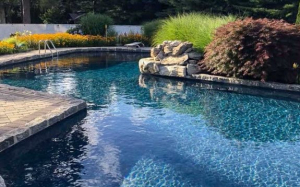
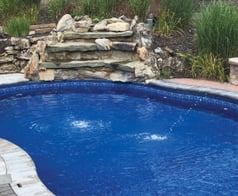
- Aqua: A color that blends blue with subtle green undertones for a vivid tropical effect. Aqua produces vibrant, resort-style water color and enhances the appearance of natural stone, waterfalls, and lush greenery around the pool.
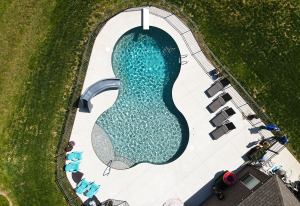
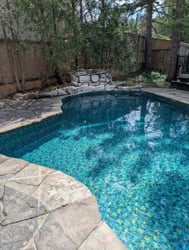
Pattern tips
- Tile borders: visually raise the waterline. Great alongside modern coping.
- Full-print floors: hide seam lines and camouflage minor debris.
- Mosaics & geometrics: complement Mediterranean or contemporary hardscapes. Check repeat alignment on curved walls.
Remember: darker inks fade sooner, especially on south-facing walls, so balance style with maintenance expectations.
How to Measure for a Pool Liner
- Gather the right tools: A soft tailor’s tape (100 ft), a chalk line, a plumb bob, a straight 2 × 4 or level, and an extra set of hands.
- Map the perimeter: For rectangles, record waterline length and width, then the same dimensions on the floor. For free-form shapes, snap a 2-ft grid across the deck and mark every intersection distance to the waterline.
- Log every depth change: Measure the shallow end, deep end, and the exact slope length (the distance from where the floor breaks to the deepest point). Note any hopper angles in inground pools or expandable depths in above-grounds.
- Detail steps, benches, and coves: Write down tread width, riser height, setback, and radius of any curved step. Above-ground owners should also measure the cove height and wall height, from coping to floor.
- Verify diagonals: On rectangles, check both corner-to-corner diagonals—if they don’t match, the shape is actually a parallelogram, and the liner must be cut accordingly.
- Double-check, and re-check, uncertain numbers: If a measurement looks off, drain the pool a few inches and measure again. The cost of extra water is far less than a liner cut too short.
- Know when to call in help: If the pool has complex radius corners, multiple depth transitions, or vinyl-over steps, professional measuring guarantees a precision fit and maintains your warranty.
If any number is unclear, drain the pool partially and re-measure. Precision is cheaper than a replacement liner. For additional tips, take a look at our guide: How to Measure and Order a Replacement Vinyl Pool Liner.
Above Ground vs. Inground Pool Liners
| Feature | Above-ground | Inground |
| Typical thickness | 20 gauge (≈12 mil) standard, up to 35 gauge (≈25 mil) upgrade | 20-30 mil, wall and floor often differ |
| Bead style | Overlap, J-hook, standard bead | Inground bead or custom cut with vinyl-over steps |
| Pattern range | Dozens. Limited by wall height repeats | Hundreds. Border + floor combos |
| Installation demands | DIY-friendly, fewer tools | May require vac-set and crew to avoid wrinkles |
| Cost to replace | Lower material cost, shorter life cycle | Higher material & labor but longer warranties |
How to Choose a Pool Liner - FAQs
How long should a vinyl pool liner last?
- With balanced water and a proper winter close-down, most vinyl liners run 7–10 years. In gentler climates they can stretch to 12–14.
Does a darker liner make the water warmer?
- A bit. Deep blues and teals absorb more sun, typically nudging temps up 2–3 °F while hiding fine debris. They also fade sooner, so weigh style against upkeep. For a closer look at color trade-offs, see our overview of above-ground liner choices.
Is a thicker pool liner always better?
- Not automatically. A snug 20 mil liner can outperform a loose 27 mil liner. Thicker vinyl adds puncture resistance but is heavier and harder to stretch into tight corners.
Will my new liner have wrinkles?
- It shouldn’t. Warm vinyl, a liner vacuum, and steady filling pressure pull the material tight. Cold installs, trapped air, or mis-measured corners are the usual wrinkle culprits.
Can I install a pool liner myself?
- Above-ground: Many owners swap an overlap liner in a weekend. Our step-by-step DIY replacement guide covers the process.
- Inground: Possible for skilled crews, but plan on pro help for vac-setting and deep-end safety ledges to protect your warranty.


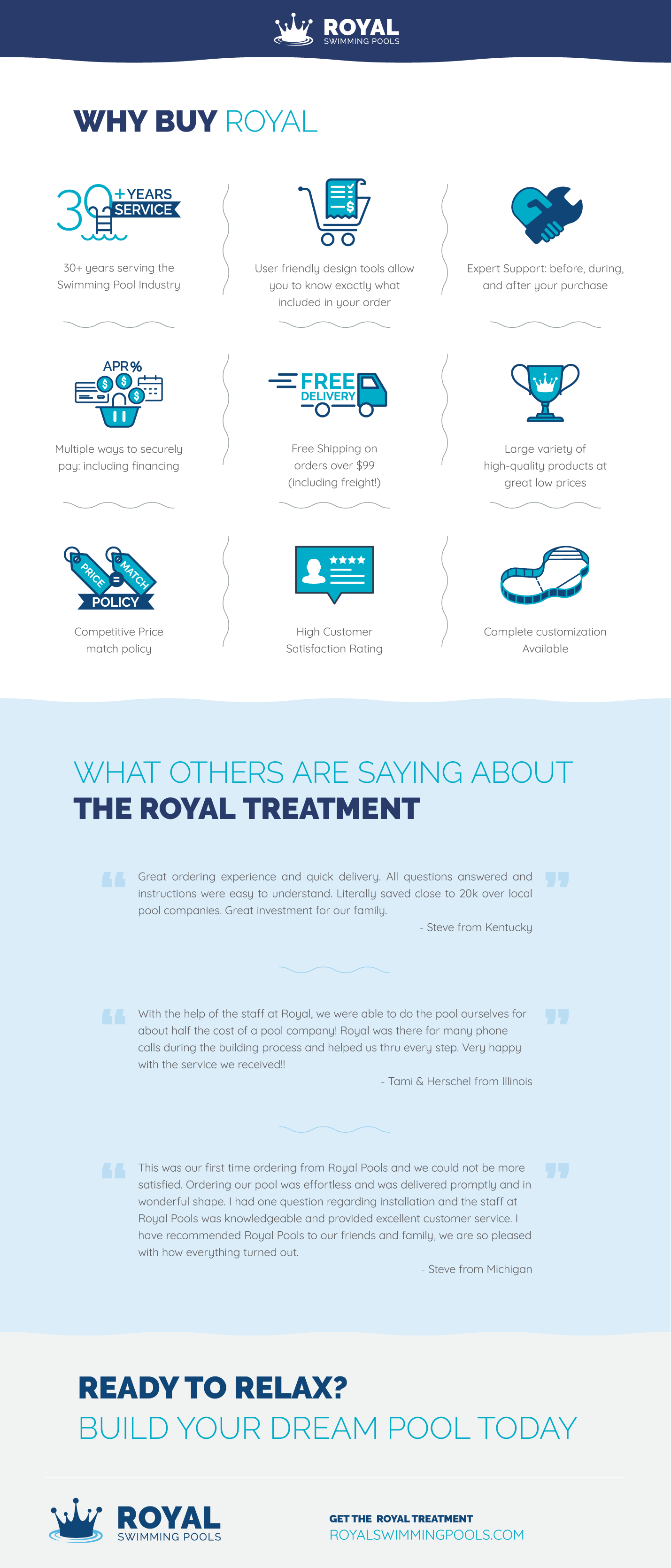

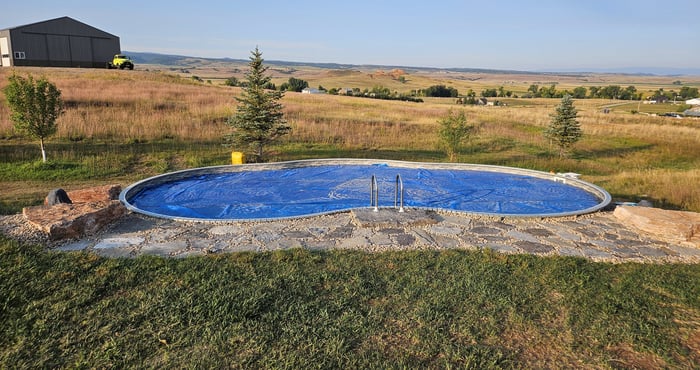
.jpg?width=700&name=Royal%20Swimming%20Pools%20INstallatin%20Team%20(9).jpg)

